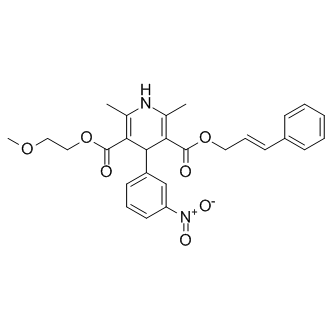
Cilnidipine
CAS No. 132203-70-4
Cilnidipine( FRC-8653 )
Catalog No. M11300 CAS No. 132203-70-4
A dual L- and N-type calcium channel blocker that displays antihypertensive, sympatholytic and neuroprotective activity.
Purity : >98% (HPLC)
 COA
COA
 Datasheet
Datasheet
 HNMR
HNMR
 HPLC
HPLC
 MSDS
MSDS
 Handing Instructions
Handing Instructions
| Size | Price / USD | Stock | Quantity |
| 10MG | 37 | In Stock |


|
| 50MG | 73 | In Stock |


|
| 100MG | 121 | In Stock |


|
| 200MG | 150 | In Stock |


|
| 500MG | Get Quote | In Stock |


|
| 1G | Get Quote | In Stock |


|
Biological Information
-
Product NameCilnidipine
-
NoteResearch use only, not for human use.
-
Brief DescriptionA dual L- and N-type calcium channel blocker that displays antihypertensive, sympatholytic and neuroprotective activity.
-
DescriptionA dual L- and N-type calcium channel blocker that displays antihypertensive, sympatholytic and neuroprotective activity. Hypertension Approved(In Vitro):Cilnidipine inhibits the L-type current with an IC50 of 100 nM in neurons pretreated with omegaCgTx plus omegaAgTx.The IC50 for Cilnidipine in respect of the N-type current is 200 nM.Cilnidipine dose- and time-dependently inhibits Ba2+ currents in A7r5 cells with the IC50 at 10 nM after 10 min.Cilnidipine dose-dependently inhibits depolarization- and Ca2+-induced contractions of rat aortic rings, with an IC50 of 10 nM at 10 min.The viability of nPC12 cells show no significant change up to 150?μM Cilnidipine, but it decreases slightly in the cells treated with greater than 200?μM Cilnidipine.Cilnidipine (100 μM, 2 hours) treatment increases the expression of p85aPI3K p-Akt, p-GSK-3β, and heat shock transcription factor (HSTF-1), and decreases levels of cytosolic cytochrome c, activated caspase 3, and cleaved PARP. (In Vivo):Cilnidipine has potent inhibitory actions on N-type as well as L-type voltage-dependent Ca2+-channel in rat dorsal root ganglion neurons.Administration of Cilnidipine (10 mg/kg) and Nimodipine (10 mg/kg) significantly attenuates the immobilized stress-induced behavioral changes and restored memory deficits along with normalization of the corticosterone levels.Cilnidipine and Nimodipine produce comparable beneficial effects in restoring immobilization stress subjected mice.Oral administration of Cilnidipine (3 mg/kg) markedly lowers both systolic and diastolic blood pressure 1 hr after administration in 2K1C renal hypertensive dogs.
-
In VitroCilnidipine inhibits the L-type current with an IC50 of 100 nM in neurons pretreated with omegaCgTx plus omegaAgTx.The IC50 for Cilnidipine in respect of the N-type current is 200 nM. Cilnidipine dose- and time-dependently inhibits Ba2+ currents in A7r5 cells with the IC50 at 10 nM after 10 min. Cilnidipine dose-dependently inhibits depolarization- and Ca2+-induced contractions of rat aortic rings, with an IC50 of 10 nM at 10 min. The viability of nPC12 cells show no significant change up to 150μM Cilnidipine, but it decreases slightly in the cells treated with greater than 200μM Cilnidipine. Cilnidipine (100 μM, 2 hours) treatment increases the expression of p85aPI3K p-Akt, p-GSK-3β, and heat shock transcription factor (HSTF-1), and decreases levels of cytosolic cytochrome c, activated caspase 3, and cleaved PARP. Cell Viability Assay Cell Line:Neuronally differentiated PC12 (nPC12) cells Concentration:0, 1, 5, 10, 25, 50, 100, 150, and 200 μM Incubation Time:Treated for 2 hours; cell viability was measured after 24 hours Result:Cell viability was not affected by low concentrations up to 150 μM, but it was slightly decreased at 200 μM.Western Blot Analysis Cell Line:nPC12 cells Concentration:100 μM Incubation Time:2 hours Result:Increased the IRs of p58a PI3K, p-Akt, p-GSK-3β, and HSTF-1 and decreased the Immunoreactivities (IRs) of cytosolic cytochrome c, activated caspase 3 (17 kDa), and cleaved PARP (85 kDa).
-
In VivoCilnidipine has potent inhibitory actions on N-type as well as L-type voltage-dependent Ca2+-channel in rat dorsal root ganglion neurons. Administration of Cilnidipine (10 mg/kg) and Nimodipine (10 mg/kg) significantly attenuates the immobilized stress-induced behavioral changes and restored memory deficits along with normalization of the corticosterone levels.Cilnidipine and Nimodipine produce comparable beneficial effects in restoring immobilization stress subjected mice.Oral administration of Cilnidipine (3 mg/kg) markedly lowers both systolic and diastolic blood pressure 1 hr after administration in 2K1C renal hypertensive dogs. Animal Model:Swiss albino mice weighing 25±5 g Dosage:5 and 10 mg/kg Administration:administered i.p. 30 min prior to immobilization stress Result:Cilnidipine (10 mg/kg, i.p.) and nimodipine (10 mg/kg, i.p.) 30 min prior to subjecting immobilization stress resulted in significant attenuation of immobilization stress-induced decrease in locomotor activity. Administration with Cilnidipine (5 mg/kg, i.p.) and Nimodipine (5 mg/kg, i.p.) did not show any significant effect on the stressed mice. Administration of Cilnidipine (10 mg/kg, i.p.) and Nimodipine (10 mg/kg, i.p.) in the non-stressed mice, and vehicle in the stressed mice did not modulate locomotor activity in a significant manner.
-
SynonymsFRC-8653
-
PathwayGPCR/G Protein
-
TargetCalcium Channel
-
RecptorDualL-andN-typecalciumchannel
-
Research AreaCardiovascular Disease
-
IndicationHypertension
Chemical Information
-
CAS Number132203-70-4
-
Formula Weight492.5204
-
Molecular FormulaC27H28N2O7
-
Purity>98% (HPLC)
-
Solubility10 mM in DMSO
-
SMILESO=C(C1=C(C)NC(C)=C(C(OC/C=C/C2=CC=CC=C2)=O)C1C3=CC=CC([N+]([O-])=O)=C3)OCCOC
-
Chemical Name3,5-Pyridinedicarboxylic acid, 1,4-dihydro-2,6-dimethyl-4-(3-nitrophenyl)-, 3-(2-methoxyethyl) 5-[(2E)-3-phenyl-2-propen-1-yl] ester
Shipping & Storage Information
-
Storage(-20℃)
-
ShippingWith Ice Pack
-
Stability≥ 2 years
Reference
1. Yoshimoto R, et al. Jpn J Pharmacol. 1991 Jun;56(2):225-9.
2. Nakashima M, et al. Jpn J Pharmacol. 1991 Sep;57(1):51-61.
3. Takahara A, et al. Hypertens Res. 2003 Sep;26(9):743-7.
molnova catalog



related products
-
Cilnidipine
A dual L- and N-type calcium channel blocker that displays antihypertensive, sympatholytic and neuroprotective activity.
-
Fluspirilene
Fluspirilene (R 6218) is a non-competitive L-type calcium channel antagonist (IC50: 0.03 μM).Fluspirilene is a long-acting antipsychotic compound used in the treatment of schizophrenia.
-
Tamolarizine
Tamolarizine (Tamolarizine free base) free base is a novel calcium antagonist.



 Cart
Cart
 sales@molnova.com
sales@molnova.com


